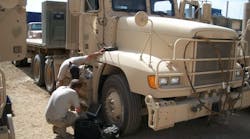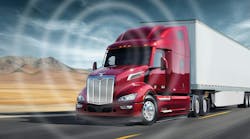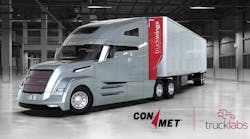Fleets are increasingly benefitting from the data produced by their vehicles to optimize maintenance plans and improve uptime. While vehicles have long produced this data, it has recently become more feasible for fleets to have the hardware, software or capabilities to transform the data into actionable information.
Both commercial fleets and the U.S. military have a common goal of maximizing vehicle uptime, and have looked to utilizing data for maintenance procedures in order to achieve this. However, both industries have different motivators and maintenance practices to meet the common goal of maximized uptime. For the U.S. military, vehicle uptime directly reflects a vehicle’s mission-readiness status. When a vehicle is not mission-ready, human lives are at stake. The U.S. military needs an extremely high degree of confidence in a vehicle’s ability to complete its mission before dispatching that vehicle.
Whereas the military is mission driven, fleets in the commercial industry are business driven. Vehicle uptime affects an organization’s ability to generate revenue and remain profitable. Additionally, there is a need to implement maintenance practices that do not affect warranty statuses; also influencing profits.
Different maintenance approaches
Noregon’s experience with both customer types gives the company an understanding of maintenance from different viewpoints.
Fleets are using their vehicle data to improve maintenance procedures by learning how their vehicles are driven. Access to data detailing driving tendencies, such as hard braking, acceleration speeds, engine load and fuel economy, as well as environmental factors such as operating temperatures and terrain, provide clarity to the vehicle’s operating conditions, which helps optimize maintenance interval requirements. Optimizing maintenance decreases the number of emergency repairs, extends the life of components and helps satisfy needs with warranty claims. These benefits all directly reflect the business mindset of commercial vehicle fleets.
Given the increased risks associated with unexpected downtime, the U.S. military takes additional measures to implement advanced practices such as condition-based maintenance plus (CBM+). The basic idea of CBM+ is to follow maintenance practices determined by algorithms to predict a failure before it happens, as opposed to maintenance based on intervals or an as-needed basis. In other words, taking a proactive versus a reactive maintenance approach.
The military is more predictive in their maintenance decisions. It is understandably more difficult to convince a fleet to replace a component showing no signs of failure than it is the military when an algorithm predicts a future failure.
Future maintenance outlook
For development and improvement of maintenance programs, fleets have a major advantage over the military in regards to the amount of data their vehicles produce, plus ease of access to that data. The average commercial vehicle drives exponentially more miles per year, yielding more data to learn from and enhance maintenance practices.
The Noregon data analytics team often fields requests to review fleet data and uncover opportunities for improving fleet operations. By pairing vehicle data with maintenance records, fleets can detect which vehicle configurations are producing the best fuel economy, for example.
Fleets will continue optimizing maintenance intervals by utilizing learnings from vehicle data. When performing risk/reward analysis, it makes sense that fleets may not aim for the same level of predictive analytics used by the U.S. military.
As rapidly as vehicles are changing, what fleets learn from the data today may be outdated within a year. In addition, solving a problem upstream may have ripple effects, which may change the problem set. By routinely analyzing data and improving maintenance practices, fleets can be sure to implement the best possible programs for their current vehicle configurations.
Tim Bigwood is the COO of Noregon. Bigwood oversees the company’s operations and marketing departments, in addition to military business development, contract administration, security and long-term planning and strategy. Prior to joining Noregon, Bigwood was the SVP of Operations at InterAct, where he led teams responsible for the implementation and support of their global product portfolio. Bigwood was also a Signal Officer and Paratrooper in the 82nd Airborne Division for the U.S. Army.




